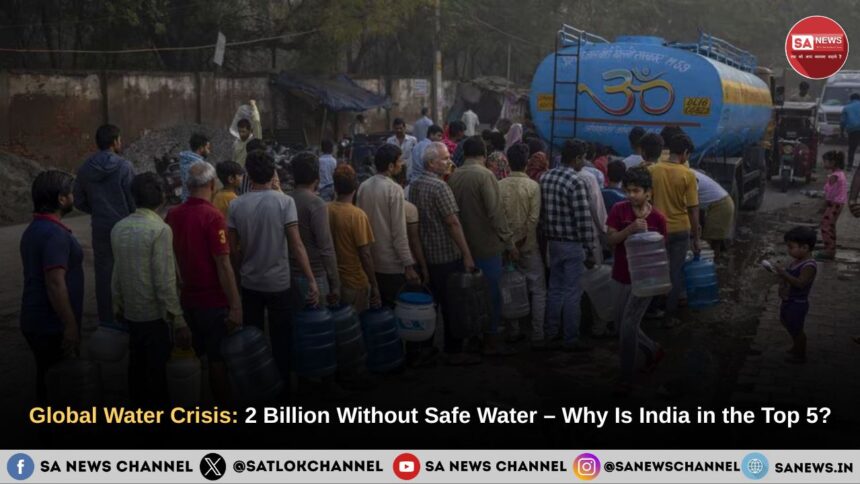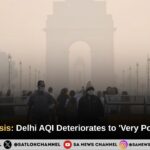Water is no longer just the foundation of life, it has become the epicenter of a global crisis. Currently, 2.2 billion people lack access to safely managed drinking water (WHO/UNICEF, 2023).
If current trends continue, 1.6–2 billion may still face this challenge by 2030. According to the World Resources Institute (WRI) and World Bank, India ranks among the top 5 countries by affected population. With 1.4 billion people but only 4% of global freshwater, the nation is under severe strain. Climate change, rapid urbanization, excessive agricultural use, and pollution are accelerating the crisis.
This blog examines 2026 projections, India’s critical situation, root causes, and practical solutions. Acting now is non-negotiable. Let’s explore how individuals, communities, and governments can win this water war together.
The Global Water Crisis: A Terrifying Picture by 2026
Over 2.2 billion people currently rely on unsafe water sources (WHO/UNICEF, 2023). Without accelerated action, 1.6–2 billion could still lack safely managed drinking water by 2030. The UN World Water Development Report (2024) warns that 4 billion people already face severe scarcity for at least one month annually, projected to rise to 5 billion by 2050.
Climate change intensifies droughts, threatening up to 40% of global water demand. The crisis extends beyond thirst:
Health: ~400,000 children under 5 die yearly from diarrhea linked to unsafe water.
Economy: Water stress could reduce GDP growth by 6% in affected regions by 2050 (World Bank).
Ecosystems: Rivers and wetlands are drying up.
By 2026, Africa and Asia will bear the heaviest burden, with agriculture consuming 70% of freshwater globally.
India’s Water Crisis: Why in the Top 5?
NITI Aayog (2018) estimates 600 million Indians face extreme water stress today. By 2025–2030, this could rise to 600–750 million. The WRI Aqueduct Atlas ranks India among 25 nations using over 80% of available water annually.
Cities like Chennai (2019 crisis) highlight the urban risk—water trains may become routine by 2026. The World Bank and WRI’s analysis of the crisis by total affected population, a factor of both high water stress and massive population size is what places India among the top 5 most critical nations globally. The World Bank reports that over 20 million Indians are directly impacted by water scarcity.
Causes: Why Is This Crisis Deepening?
Climate Change & Droughts
- Irregular monsoons disrupt recharge cycles.
- Himalayan glaciers (feeding the Ganga basin) are melting 2× faster than in the 20th century, threatening 50 million people.
- Drought frequency in India has risen ~20% in recent decades.
Urbanization & Industrial Use
- Urban population will hit 600 million by 2030, doubling demand.
- 80% of industrial wastewater is discharged untreated, contaminating groundwater.
Excessive Agricultural Consumption
- Agriculture uses 80% of India’s water.
- 60% is wasted via flood irrigation (Central Water Commission).
- Even in high-rainfall years, poor management triggers shortages.
Also Read: Water Conservation: The Need of the Hour
Solutions: Immediate Actions Needed
Government Initiatives
- Jal Jeevan Mission: By 2024, 15 crore+ households gained tap connections (75 million+ people). Full coverage target: 2028.
- World Bank Support: $1.2 billion project improving rural supply for 20 million+
- Namami Gange & Atal Bhujal Yojana: River cleanup + groundwater recharge.
- Chennai Model: Wastewater recycling now meets 20% of industrial demand.
Individual & Community Actions
- Install rainwater harvesting (one rooftop system = 50,000 liters/year saved).
- Switch to drip irrigation (saves 50–70% water in farms).
- Run local awareness drives—one campaign can reach 1,000 households.
- Reuse greywater for flushing/gardening.
Technological Solutions
- AI water management platforms (e.g., smart metering) reduce leaks by 30%.
- Global need: $131–140 billion annually to achieve SDG 6 by 2030.
Humanitarian Aid and Water Management by the Annapurna Mission
As we all know that water is a gift to mankind that gives life to a human; one cannot live without water. In recent days, Saint Rampal Ji Maharaj has demonstrated the true spirit of devotion through action by helping hundreds of villages in North India under His Annapurna Mission. This extensive humanitarian effort provided crucial, rapid relief by supplying high-power submersible motors and thousands of feet of industrial pipeline to urgently pump out destructive floodwaters from submerged fields and homes.
Along with this flood mitigation and agricultural recovery work, the Mission also helped villagers and farmers by permanently installing drinking water hand pumps in communities that had suffered from chronic drinking water shortages for many years, proving that genuine spiritual guidance translates directly into life-saving service to humanity.
Ultimately, these actions remind us that we must prioritize saving water and caring for our natural resources today for a better future, which helps in nature’s healing and prevents the recurrence of devastating flood-like situations.
FAQs on Global Water Crisis
Q1 How many Indians may face severe water stress by 2026?
A: 600–750 million, especially in rural and peri-urban areas. (Source: NITI Aayog & World Bank projections)
Q2 What are the main causes?
A: Climate change, pollution, urbanization, and inefficient agricultural use.
Q3 How can I save water at home?
A: Close taps while brushing, reuse greywater, install rainwater harvesting.
Q4 What are key Government schemes?
A: Jal Jeevan Mission, Namami Gange, Atal Bhujal Yojana.
Q5: What are global solutions?
A: $140 billion annual investment in infrastructure + sustainable practices to meet SDG 6.









